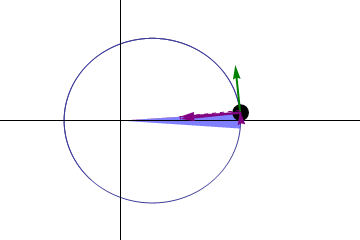After meticulously calculating the data that Tycho Brahe collected, Kepler discovered three different laws that described how planets move.
Kepler’s First Law – The planets orbit in ellipses, not circles nor epicycles. For majority of history, it was thought that planets orbit through epicycles because the orbit of the planets must be perfect. However, the planets actually move in ellipses that have eccentricity very close to 1. They may look like circles, but they are actually ellipses since their eccentricity is not 1.
Kepler’s Second Law – The planet sweeps out equal areas in equal time. In a circle, the centripetal force is pointing towards the center and perpendicular to the velocity. Therefore, the force only changes the velocity’s direction, not its magnitude. However, in an elliptical orbit, the force is direction towards the focal point. Therefore, part of the force is in the same direction as the velocity and part of the force is perpendicular to the velocity. So, the velocity not only changes direction, but also changes in magnitude. The velocity begins to increase. As the velocity increases, the planet travels a greater distance getting closer to the sun. For every unit distance that the planet travels, the area it sweeps out for that unit distance traveled gets smaller. So, if the planet travels faster and covers a greater distance during that time, then it sweeps out a larger area than the unit distance. This all averages out in the end. So, for every unit time, the planet sweeps out equal amounts of area.

Caption: This is image from Wikipedia. The velocity vector is green. The diagonal purple line is the net force, which is pointing to the Sun. The two other purple lines are the components of the force, one in the direction of the velocity, the other perpendicular to the velocity vector. If you look very closely, the white lines chop up the pink area into slices of equal area.
Kepler’s 3rd Law – The square of the period of the planet’s orbit around the Sun is proportional to the cube of the distance from the Sun to the planet. Kepler was only able to show that these values were directly proportional. He was not able to figure out the constant of proportionality. It wasn’t until Newton’s Law of Gravitation that the constant of proportionality was determined. More specifically, the constant of proportionality is 4 times pi divided by the product of gravitational constant and the combined mass of the system.
Leave a comment